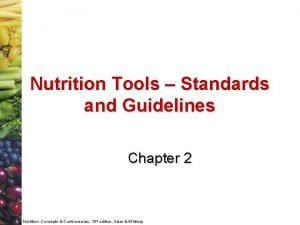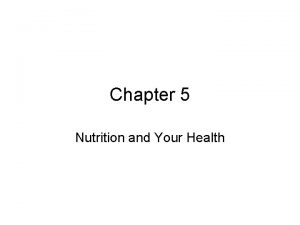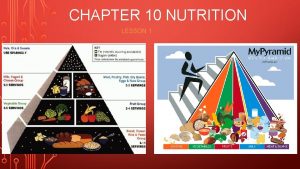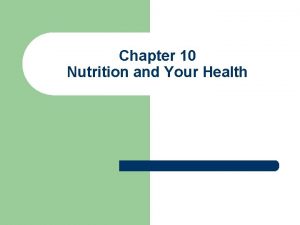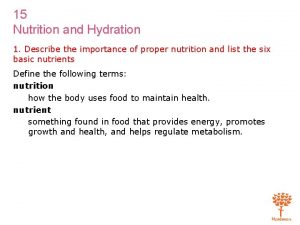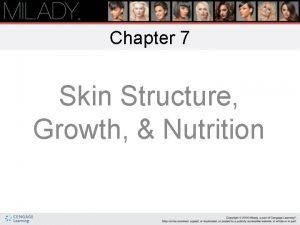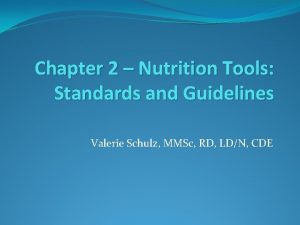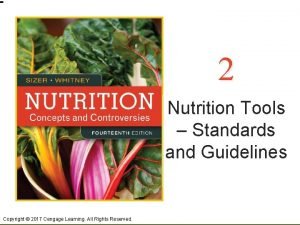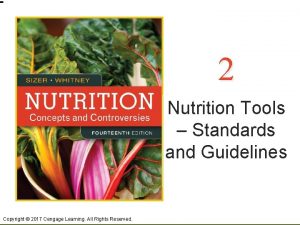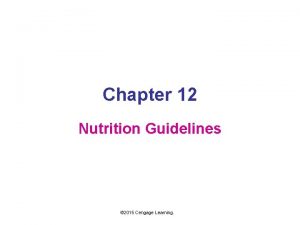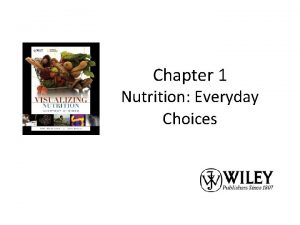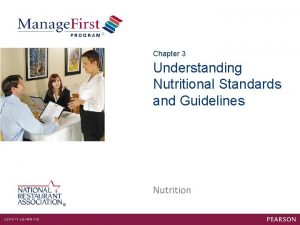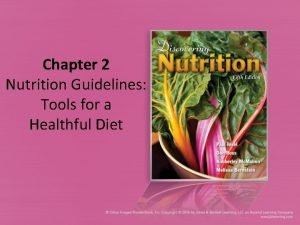Chapter 2 Nutrition Tools Standards and Guidelines Sizer
























- Slides: 24

Chapter 2 Nutrition Tools— Standards and Guidelines Sizer and Whitney, Nutrition: Concepts and Controversies, 15 th Edition. © 2020 Cengage. All Rights Reserved. May not be scanned, copied or duplicated, or posted to a publicly accessible website, in whole or in part.

Learning Objectives (Slide 1 of 2) • State the significance of Dietary Reference Intakes (D R I) and Daily Values as nutrient standards • Define the role of the Dietary Guidelines as part of the overall U. S. dietary guidance system • Describe how the U S D A Eating Patterns support the planning of a nutritious diet • Given a specified number of calories, create a healthful diet plan using the U S D A Eating Patterns Sizer and Whitney, Nutrition: Concepts and Controversies, 15 th Edition. © 2020 Cengage. All Rights Reserved. May not be scanned, copied or duplicated, or posted to a publicly accessible website, in whole or in part.

Learning Objectives (Slide 2 of 2) • Describe the information that appears on food labels • Compare one day’s nutrient-dense meals with meals not planned for nutrient density • Summarize the potential health effects of phytochemicals from both food sources and supplements Sizer and Whitney, Nutrition: Concepts and Controversies, 15 th Edition. © 2020 Cengage. All Rights Reserved. May not be scanned, copied or duplicated, or posted to a publicly accessible website, in whole or in part.

Nutrient Recommendations (Slide 1 of 6) • Sets of standards against which people’s nutrient and energy intakes can be measured • Dietary Reference Intakes (D R I): Set of five lists of values for measuring the nutrient intakes of healthy people in the United States and Canada • Values set for vitamins and minerals, carbohydrates, lipids, protein, fiber, water, and energy • Daily Values: Nutrient standards used on food labels and on grocery store and restaurant signs Sizer and Whitney, Nutrition: Concepts and Controversies, 15 th Edition. © 2020 Cengage. All Rights Reserved. May not be scanned, copied or duplicated, or posted to a publicly accessible website, in whole or in part.

Nutrient Recommendations (Slide 2 of 6) • The D R I lists and purposes • Recommended Dietary Allowances (R D A) • Nutrient intake goals for individuals; the average daily nutrient intake level that meets the needs of nearly all healthy people in a particular life stage and gender group • Adequate Intakes (A I) • Nutrient intake goals for individuals set when scientific data are insufficient to allow establishment of an R D A value and assumed to be adequate for healthy people • Tolerable Upper Intake Levels (U L) • The highest average daily nutrient intake levels that are likely to pose no risk of toxicity to almost all healthy individuals of a particular life stage and gender group Sizer and Whitney, Nutrition: Concepts and Controversies, 15 th Edition. © 2020 Cengage. All Rights Reserved. May not be scanned, copied or duplicated, or posted to a publicly accessible website, in whole or in part.

Nutrient Recommendations (Slide 3 of 6) • Estimated Average Requirements (E A R) • Nutrient values used in nutrition research and policy making and the basis upon which R D A values are set; the average daily nutrient intake estimated to meet the requirement of half of the healthy individuals in a particular life stage and gender group • Acceptable Macronutrient Distribution Ranges (A M D R) • Values for carbohydrate, fat, and protein expressed as percentages of total daily caloric intake; ranges of intakes set for the energy-yielding nutrients that are sufficient to provide adequate total energy and nutrients while minimizing the risk of chronic diseases Sizer and Whitney, Nutrition: Concepts and Controversies, 15 th Edition. © 2020 Cengage. All Rights Reserved. May not be scanned, copied or duplicated, or posted to a publicly accessible website, in whole or in part.

Nutrient Recommendations (Slide 4 of 6) • RDA • Meet needs of almost all healthy people • Derived from solid experimental evidence and reliable observations • AI • Based on scientific evidence and educated guesswork • A I values are established only when there is insufficient evidence to generate an R D A Sizer and Whitney, Nutrition: Concepts and Controversies, 15 th Edition. © 2020 Cengage. All Rights Reserved. May not be scanned, copied or duplicated, or posted to a publicly accessible website, in whole or in part.

Nutrient Recommendations (Slide 5 of 6) • E A R—nutrition research and policy • Establishes the average nutrient requirements for a given life stage and gender group • Used by nutrition researchers and policy makers • Used by public health officials to assess nutrient intake of populations • U L—safety • Identify potentially toxic levels of nutrient intake • Caution is in order when nutrient intakes approach the U L values Sizer and Whitney, Nutrition: Concepts and Controversies, 15 th Edition. © 2020 Cengage. All Rights Reserved. May not be scanned, copied or duplicated, or posted to a publicly accessible website, in whole or in part.

Nutrient Recommendations (Slide 6 of 6) • A M D R—calorie percentage ranges • D R I committee also sets healthy ranges of intake for carbohydrate, fat, and protein • Carbohydrate: 45 to 65 percent of total calorie intake • Fat: 20 to 35 percent of total calorie intake • Protein: 10 to 35 percent total calorie intake Sizer and Whitney, Nutrition: Concepts and Controversies, 15 th Edition. © 2020 Cengage. All Rights Reserved. May not be scanned, copied or duplicated, or posted to a publicly accessible website, in whole or in part.

Figure 2. 2: The Naïve View versus the Accurate View of Optimal Nutrient Intakes A common but naïve belief is that consuming less than the D R I amount of a nutrient is dangerous, but that consuming any amount more is safe. The accurate view, shown on the right, is that D R I values fall within a safety range, with the U L marking tolerable upper levels. Sizer and Whitney, Nutrition: Concepts and Controversies, 15 th Edition. © 2020 Cengage. All Rights Reserved. May not be scanned, copied or duplicated, or posted to a publicly accessible website, in whole or in part.

Understanding the D R I (Slide 1 of 2) • Nutritional recommendations are made for specific groups of people • Adequate nutrition intake: Attempt to get 100% of D R I recommended intake over time • Characteristics of the D R I • Values reflect daily intakes to be achieved on average, over time • Based on concepts of probability and risk • Optimum intakes, not minimum • Values are set in reference to certain indicators of nutrient adequacy Sizer and Whitney, Nutrition: Concepts and Controversies, 15 th Edition. © 2020 Cengage. All Rights Reserved. May not be scanned, copied or duplicated, or posted to a publicly accessible website, in whole or in part.

Understanding the D R I (Slide 2 of 2) • D R I are not designed for restoration of health or repletion of nutrients in those with deficiencies • Designed for health maintenance and disease prevention in healthy people Sizer and Whitney, Nutrition: Concepts and Controversies, 15 th Edition. © 2020 Cengage. All Rights Reserved. May not be scanned, copied or duplicated, or posted to a publicly accessible website, in whole or in part.

How the Committee Establishes D R I Values—An R D A Example • Determining individual requirements • Balance study: Laboratory study in which a subject is fed a controlled diet and the intake and excretion of a nutrient are measured; not valid for all nutrients • A requirement to establish balance is determined for each individual subject • Accounting for needs of the population • The value is set high enough so that 97 to 98 percent of the population will be covered but not so high as to be excessive Sizer and Whitney, Nutrition: Concepts and Controversies, 15 th Edition. © 2020 Cengage. All Rights Reserved. May not be scanned, copied or duplicated, or posted to a publicly accessible website, in whole or in part.

Figure 2. 3: Individuality of Nutrient Requirements Each square represents a person. A, B, and C are Mr. A, Mr. B, and Mr. C. Each has a different requirement. Sizer and Whitney, Nutrition: Concepts and Controversies, 15 th Edition. © 2020 Cengage. All Rights Reserved. May not be scanned, copied or duplicated, or posted to a publicly accessible website, in whole or in part.

Figure 2. 4: Nutrient Recommended Intake: Example Intake recommendations for most vitamins and minerals are set so that they will meet the requirements of nearly all people. a. Estimated Average Requirement Sizer and Whitney, Nutrition: Concepts and Controversies, 15 th Edition. © 2020 Cengage. All Rights Reserved. May not be scanned, copied or duplicated, or posted to a publicly accessible website, in whole or in part.

Setting Energy Requirements • Estimated Energy Requirements (E E R) • Not generous • Set to maintain healthy body weight • Apply to individual of particular age, gender, height, weight, and activity level • Too much energy causes unhealthy weight gain Sizer and Whitney, Nutrition: Concepts and Controversies, 15 th Edition. © 2020 Cengage. All Rights Reserved. May not be scanned, copied or duplicated, or posted to a publicly accessible website, in whole or in part.

Why Are Daily Values Used on Labels? • Food labels must list a single value for each nutrient that may be used by anyone • Reflect the highest level of nutrient need among all population groups • Allow comparisons among foods • Do not serve as nutrient intake goals for individuals Sizer and Whitney, Nutrition: Concepts and Controversies, 15 th Edition. © 2020 Cengage. All Rights Reserved. May not be scanned, copied or duplicated, or posted to a publicly accessible website, in whole or in part.

Dietary Guidelines for Americans • Offer food-based strategies for achieving D R I values • Promote health • Current U. S. diet • Important nutrients undersupplied • Less healthful nutrients oversupplied • Exercise is important to maintaining healthy body weight Sizer and Whitney, Nutrition: Concepts and Controversies, 15 th Edition. © 2020 Cengage. All Rights Reserved. May not be scanned, copied or duplicated, or posted to a publicly accessible website, in whole or in part.

Dietary Guidelines for Americans 2015– 2020: Guidelines and Recommendations (Slide 1 of 4) • The Dietary Guidelines and key recommendations should be applied in their entirety to people 2 years of age and older; they are interconnected and each component can affect the others • Dietary Guidelines • Follow a healthy eating pattern across the life span. All food and beverage choices matter. Choose a healthy eating pattern at an appropriate calorie level to help achieve and maintain a healthy body weight, support nutrient adequacy, and reduce the risk of chronic disease Sizer and Whitney, Nutrition: Concepts and Controversies, 15 th Edition. © 2020 Cengage. All Rights Reserved. May not be scanned, copied or duplicated, or posted to a publicly accessible website, in whole or in part.

Dietary Guidelines for Americans 2015– 2020: Guidelines and Recommendations (Slide 2 of 4) • Focus on variety, nutrient density, and amount. To meet nutrient needs within calorie limits, choose a variety of nutrient-dense foods across and within all food groups in recommended amounts • Limit calories from added sugars and saturated fats and reduce sodium intake. Consume an eating pattern low in added sugars, saturated fats, and sodium. Cut back on foods and beverages higher in these components to amounts that fit within healthy eating patterns • Shift to healthier food and beverage choices. Choose nutrientdense foods and beverages across and within all food groups in place of less healthy choices. Consider cultural and personal preferences to make these shifts easier to accomplish and maintain Sizer and Whitney, Nutrition: Concepts and Controversies, 15 th Edition. © 2020 Cengage. All Rights Reserved. May not be scanned, copied or duplicated, or posted to a publicly accessible website, in whole or in part.

Dietary Guidelines for Americans 2015– 2020: Guidelines and Recommendations (Slide 3 of 4) • Support healthy eating patterns for all. Everyone has a role in helping to create and support healthy eating patterns in multiple settings nationwide, from home to school to work to communities • Key recommendations • Consume a healthy eating pattern that accounts for all foods and beverages within an appropriate calorie level • A healthy eating pattern includes: • A variety of vegetables from all of the subgroups—dark green, red and orange, legumes (beans and peas), starchy, and other • Fruit, especially whole fruit • Grains, at least half of which are whole grains Sizer and Whitney, Nutrition: Concepts and Controversies, 15 th Edition. © 2020 Cengage. All Rights Reserved. May not be scanned, copied or duplicated, or posted to a publicly accessible website, in whole or in part.

Dietary Guidelines for Americans 2015– 2020: Guidelines and Recommendations (Slide 4 of 4) • Fat-free or low-fat dairy, including milk, yogurt, cheese, and/or fortified soy beverages • A variety of protein foods, including seafood, lean meats and poultry, eggs, legumes (beans and peas), and nuts, seeds, and soy products • Oils • A healthy eating pattern limits: • Saturated fats and trans fats, added sugars, and sodium: (a) Consume less than 10 percent of calories per day from added sugars, (b) Consume less than 10 percent of calories per day from saturated fats, and (c) Consume less than 2, 300 milligrams per day of sodium • If alcohol is consumed, it should be consumed in moderation—up to one drink per day for women and up to two drinks per day for men— and only by adults of legal drinking age Source: U. S. Department of Health and Human Services and U. S. Department of Agriculture, 2015– 2020 Dietary Guidelines for Americans, 8 th edition (2015), available at http: //health. gov/dietaryguidelines/2015/guidelines/. Sizer and Whitney, Nutrition: Concepts and Controversies, 15 th Edition. © 2020 Cengage. All Rights Reserved. May not be scanned, copied or duplicated, or posted to a publicly accessible website, in whole or in part.

Think Fitness: Recommendations for Daily Physical Activity • The U S D A’s Physical Activity Guidelines for Americans suggest that to maintain good health, adults should engage in at least 2. 5 hours of moderate physical activity each week • A brisk walk at a pace of about 100 steps per minute (1, 000 steps over 10 minutes) constitutes “moderate” activity • For weight control or additional health benefits, more than the minimum amount of physical activity is required Sizer and Whitney, Nutrition: Concepts and Controversies, 15 th Edition. © 2020 Cengage. All Rights Reserved. May not be scanned, copied or duplicated, or posted to a publicly accessible website, in whole or in part.

 Nutrition tools standards and guidelines
Nutrition tools standards and guidelines Nutrition tools standards and guidelines
Nutrition tools standards and guidelines Chapter 5 nutrition guidelines tools for healthful eating
Chapter 5 nutrition guidelines tools for healthful eating Packing arrangement of powder slideshare
Packing arrangement of powder slideshare Hpe storage sizing tool
Hpe storage sizing tool Specsizer
Specsizer Hyper sizer
Hyper sizer European quality assurance standards
European quality assurance standards Customer defined service standards
Customer defined service standards Six ministerial priorities department health
Six ministerial priorities department health Chapter 7 nutrition and your fitness
Chapter 7 nutrition and your fitness Chapter 7 nutrition and your fitness
Chapter 7 nutrition and your fitness A saturated fatty acid holds all the hydrogen atoms it can.
A saturated fatty acid holds all the hydrogen atoms it can. Chapter 4 nutrition and your personal fitness
Chapter 4 nutrition and your personal fitness Chapter 11 nutrition and diets key terms
Chapter 11 nutrition and diets key terms Chapter 11 nutrition and diets key terms
Chapter 11 nutrition and diets key terms Chapter 10: nutrition for health lesson 1 answer key
Chapter 10: nutrition for health lesson 1 answer key Chapter 10 lesson 4 nutrition labels and food safety
Chapter 10 lesson 4 nutrition labels and food safety Nutrition and hydration chapter 15
Nutrition and hydration chapter 15 Chapter 6 microbial nutrition and growth
Chapter 6 microbial nutrition and growth Chapter 7 skin structure growth and nutrition
Chapter 7 skin structure growth and nutrition Chapter 6 microbial nutrition and growth
Chapter 6 microbial nutrition and growth Chapter 11 nutrition and diet
Chapter 11 nutrition and diet Chapter 7 nutrition and your fitness
Chapter 7 nutrition and your fitness Pour plate vs streak plate
Pour plate vs streak plate
